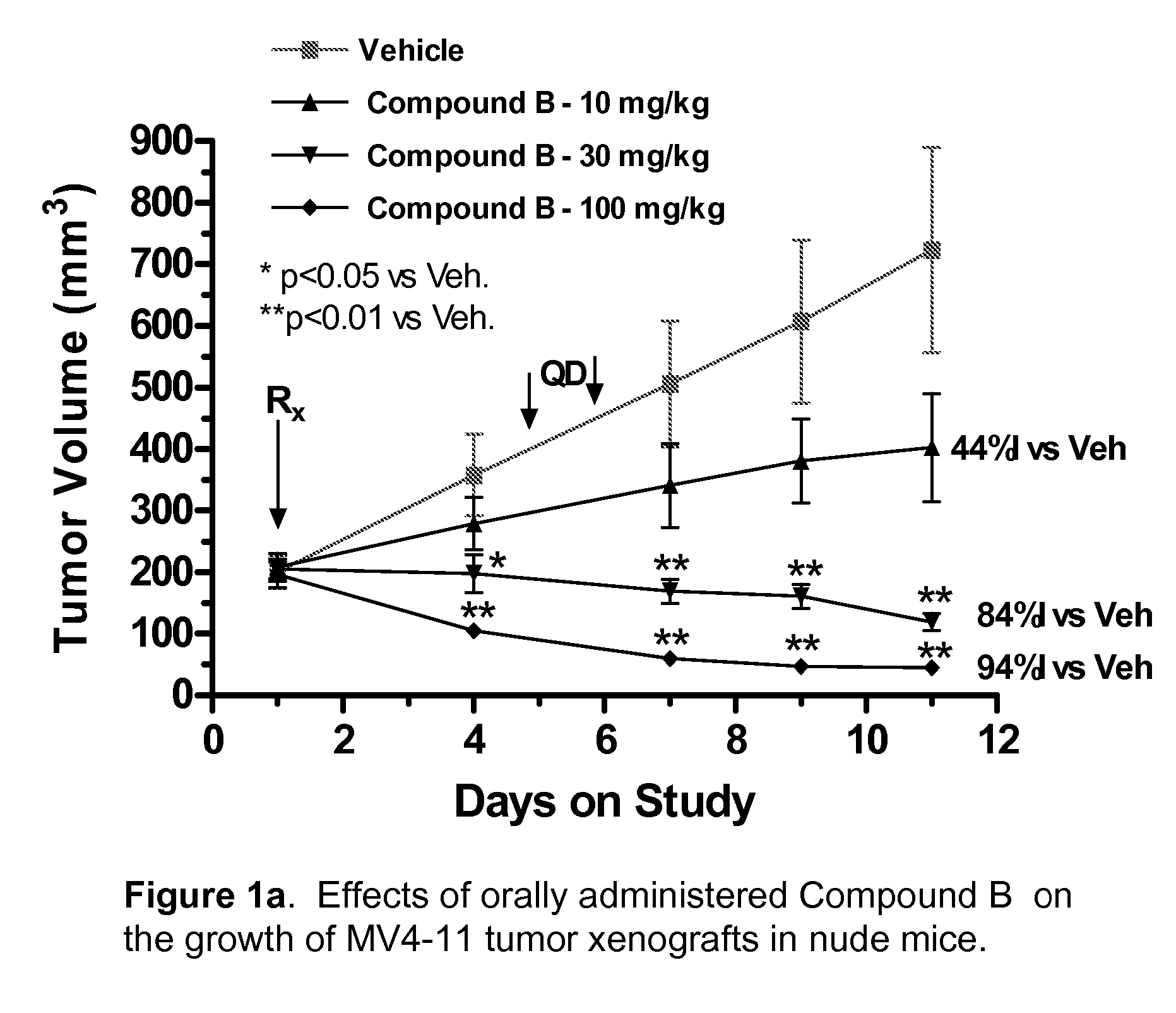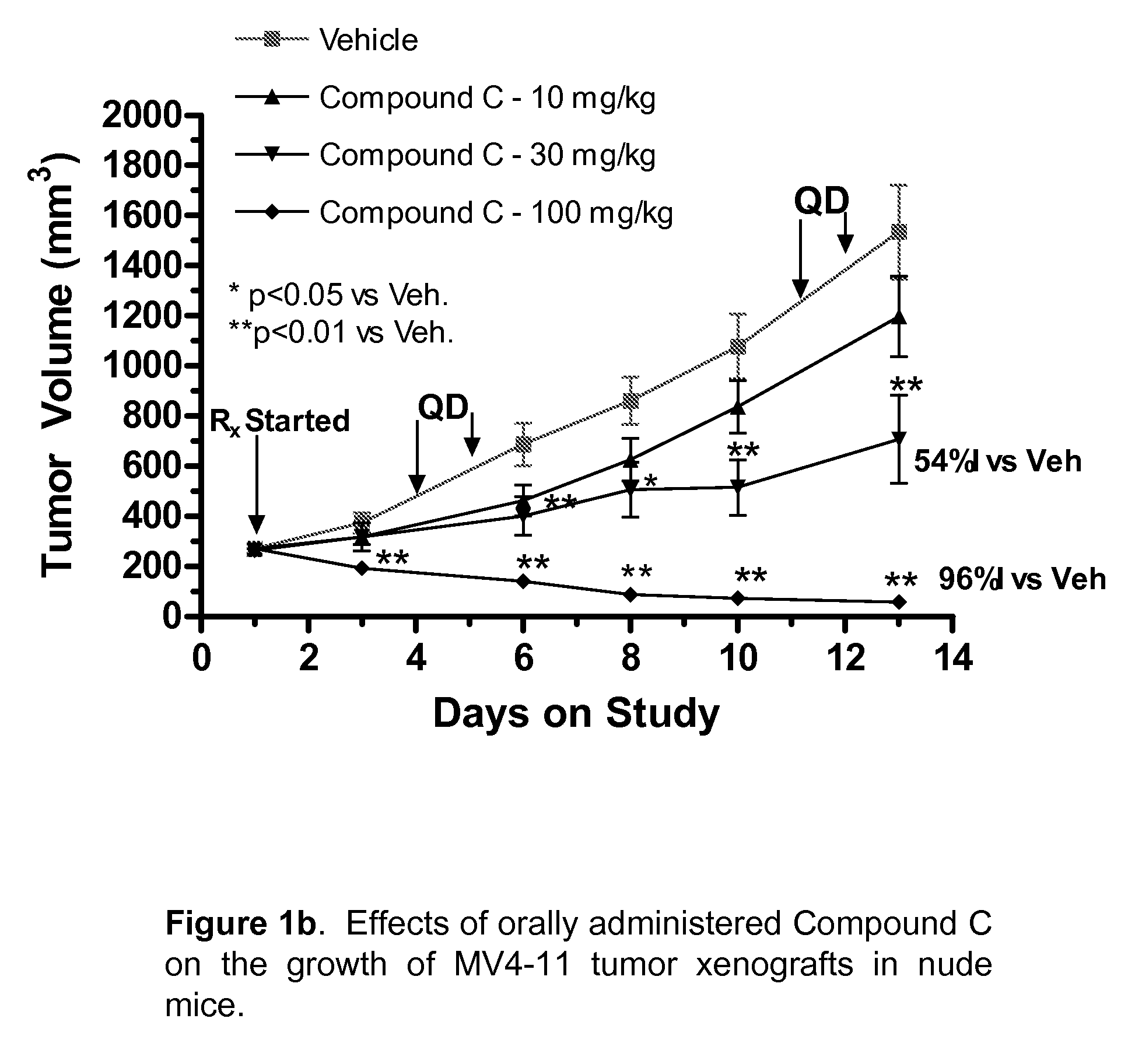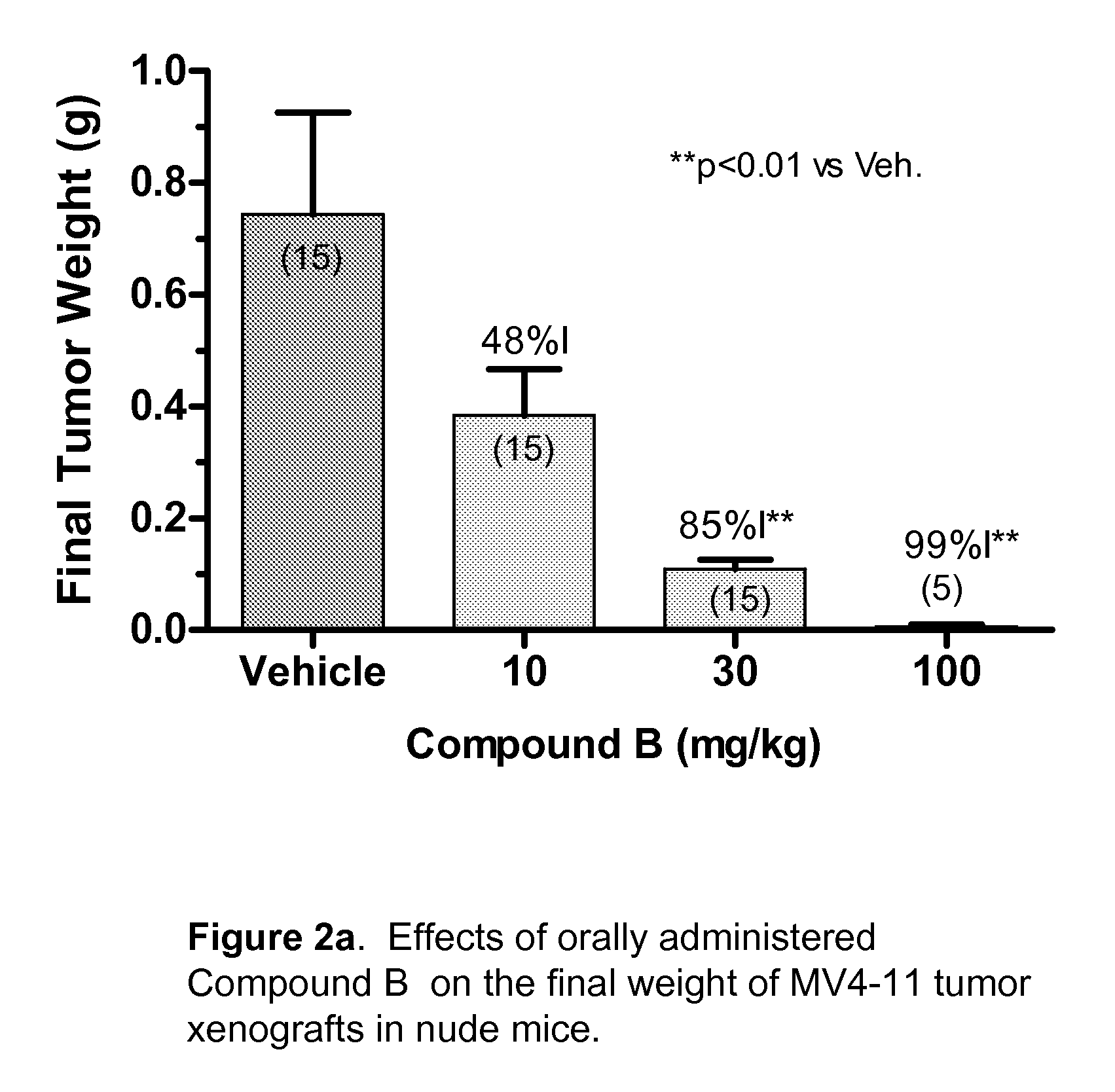Synergistic Modulation of Flt3 Kinase Using Alkylquinolines and Alkylquinazolines
a technology of flt3 kinase and alkylquinoline, which is applied in the field of cell proliferative disorders or disorders, can solve the problems of high toxicity and resistance of aml, patients with itd mutation, and significant unmet clinical need for aml, so as to achieve synergistic cytotoxic effects
- Summary
- Abstract
- Description
- Claims
- Application Information
AI Technical Summary
Benefits of technology
Problems solved by technology
Method used
Image
Examples
example 1
4-(6,7-Dimethoxy-quinazolin-4-yl)-piperidine-1-carboxylic acid (4-isopropoxy-phenyl)-amide hydrochloride
[0468]
a. (4-Isopropoxy-phenyl)-carbamic acid 4-nitro-phenyl ester
[0469]
[0470] To a solution of 4-isopropoxyaniline (9.06 g, 60.0 mmol) in DCM (120 mL) and pyridine (30 mL) was added 4-nitrophenyl chloroformate (10.9 g, 54.0 mmol) portionwise with stirring over ˜1 min with brief ice-bath cooling. After stirring at rt for 1 h, the homogeneous solution was diluted with DCM (300 mL) and washed with 0.6 M HCl (1×750 mL) and 0.025 M HCl (1×1 L). The organic layer was dried (Na2SO4) and concentrated to give the title compound as a light violet-white solid (16.64 g, 98%). 1H-NMR (300 MHz, CDCl3) δ 8.26 (m, 2H), 7.40-7.28 (m, 4H), 6.98 (br s, 1H), 6.87 (m, 2H), 4.50 (heptet, J=6.0 Hz, 1H), 1.33 (d, J=6.0 Hz, 6H). LC / MS (ESI): calcd mass 316.1. found 633.2 (2MH)+.
b. Piperidine-1,4-dicarboxylic acid 1-tert-butyl ester 4-methyl ester
[0471]
[0472] To a mixture of isonipecotic acid (39.0 g, ...
example 2
4-(6,7-Dimethoxy-quinazolin-4-yl)-piperidine-1-carboxylic acid (4-iodo-phenyl)-amide
[0480]
a. (4-Iodo-phenyl)-carbamic acid 4-nitro-phenyl ester
[0481]
[0482] The title compound was prepared from 4-iodoaniline essentially as described in Example 1a, except the reaction was stirred at rt for 3 h. The homogeneous solution was then partitioned with DCM and aq HCl essentially as described in Example 1a, except a heavy precipitate formed in the organic layer. Filtration of the organic layer provided the title compound as an off-white solid (8.50 g, 61%). 1H-NMR (400 MHz, CDCl3) 8.30 (m, 2H), 7.68 (m, 2H), 7.39 (m, 2H), 7.30-7.20 (m, 2H), 6.98 (br s, 1H).
b. 4-(6,7-Dimethoxy-quinazolin-4-yl)-piperidine-1-carboxylic acid (4-iodo-phenyl)-amide
[0483]
[0484] To a mixture of 6,7-dimethoxy-4-piperidin-4-yl-quinazoline (5.18 g, 19.0 mmol), prepared as described in Example 1d, and (4-iodo-phenyl)-carbamic acid 4-nitro-phenyl ester (8.00 g, 20.8 mmol), prepared as described in the preceding step, i...
example 3
4-(6,7-Dimethoxy-quinazolin-4-yl)-piperidine-1-carboxylic acid (4-imidazol-1-yl-phenyl)-amide
[0485]
a. 4-(6,7-Dimethoxy-quinazolin-4-yl)-piperidine-1-carbonyl chloride
[0486]
[0487] To a −78° C. solution of 1.85 M phosgene in toluene (15.8 mL, 29.3 mmol) and DCM (32 mL) was added 6,7-dimethoxy-4-piperidin-4-yl-quinazoline (4.00 g, 14.6 mmol), prepared as described in Example 1d, in one portion with stirring, followed immediately by the rapid addition of DIEA (2.66 mL, 16.1 mmol) along the walls of the flask over ˜5 sec. The flask was sealed and stirred at −78° C. for another 5 min before placing the flask in an ice bath with stirring at 0° C. for 30 min. The opaque easily stirred slurry was then poured into a mixture of DCM (70 mL), 0.5 M trisodium citrate (60 mL), and ice (60 mL), and partitioned. The aqueous layer was extracted with DCM (1×50 mL) and the organic layers combined, dried (Na2SO4), and concentrated under reduced pressure to give the crude title compound as an orange so...
PUM
| Property | Measurement | Unit |
|---|---|---|
| Molar density | aaaaa | aaaaa |
| Molar density | aaaaa | aaaaa |
| Molar density | aaaaa | aaaaa |
Abstract
Description
Claims
Application Information
 Login to View More
Login to View More - R&D
- Intellectual Property
- Life Sciences
- Materials
- Tech Scout
- Unparalleled Data Quality
- Higher Quality Content
- 60% Fewer Hallucinations
Browse by: Latest US Patents, China's latest patents, Technical Efficacy Thesaurus, Application Domain, Technology Topic, Popular Technical Reports.
© 2025 PatSnap. All rights reserved.Legal|Privacy policy|Modern Slavery Act Transparency Statement|Sitemap|About US| Contact US: help@patsnap.com



